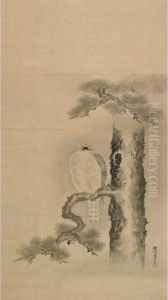Kano Naganobu Paintings
Kano Naganobu was a prominent Japanese painter born in 1577, during Japan's Azuchi-Momoyama period, and he played a significant role in shaping the Kano school of painting during the early Edo period, passing away in 1654. He was a member of the esteemed Kano family, which was instrumental in developing one of the most influential schools of painting in Japanese history. The Kano school dominated Japanese painting for more than three centuries, and Naganobu's contributions were crucial in the early stages of its development. His work is characterized by a blend of robust dynamism and delicate detail, embodying the aesthetic preferences of the warrior class and nobility of his time.
Naganobu was trained by his father, Kano Eitoku, who was one of the most celebrated painters of the Azuchi-Momoyama period. Under his father's tutelage, Naganobu honed his skills in the family's signature styles, incorporating Chinese-inspired landscapes, birds-and-flowers motifs, and screen paintings that displayed a grandeur fitting for the castles and temples they adorned. After his father's death, Naganobu continued to serve the Tokugawa shogunate, the new ruling power of Japan, thereby ensuring the Kano school's patronage into the Edo period. This transition marked a new chapter for the Kano school, as it adapted to the tastes and demands of the Tokugawa regime.
Throughout his career, Kano Naganobu worked on numerous prestigious commissions, including the creation of fusuma (sliding door panels) and byobu (folding screens) for castles and residences of the shogunate and daimyo (feudal lords). His ability to blend the grandiose with the intimate in his paintings was particularly admired, a skill that made his works highly sought after. Naganobu also played a significant role in training the next generation of Kano painters, including his younger brother Kano Tan'yu, who would become one of the most influential painters of the Edo period. Through his artistic achievements and his role as a teacher, Kano Naganobu contributed to the continuity and evolution of the Kano school's legacy, cementing its status as a cornerstone of Japanese art history.
